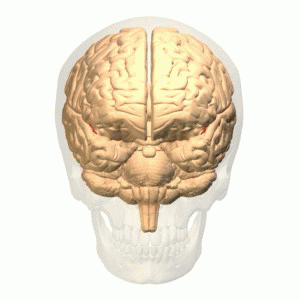After a longstanding illness caused Michael Balzer to lose his job, by 2013, his health improved for the better and he developed an independent 3d graphics career.
He was also working with his wife, Pamela Scott, on treating video game addicts. Scott's a psychotherapist,
In August of 2013, Scott began having migraines, and an MRI revealed that she had a tumor behind her left eye.
It was horrifying to the couple, but the neurologist brushed it off saying it wasn’t a big deal, and that’s when Balzer took matters into his own hands.
He requested the DICOM files (standard digital format used for medical data) from his wife’s MRI results. He then sent them to other neurologists around the country, and they mostly all of them agreed it needed to be operated on immediately.
To make matters worse, another MRI done a few months later revealed that the tumor grew in size.
Balzer decided to take the DICOM images, and used Photoshop to layer images of the smaller tumor with the more recent image of the bigger tumor.
He realized the tumor hadn’t grown, the radiologist had just measured it from a different angle.
Frustrated by the incorrect diagnosis, but inspired more than ever to take a more active role in his wife’s treatment, he decided to up the ante and convert the DICOM files into a 3D rendering.
He converted the DICOM files into 3D image by downloading a free application called InVesalius and used the 3D images to create a 3D rendering, which is used in 3D printing. (For more on 3D printing, read here: https://nyrequirements.com/blog/3d-printing-body-parts-technology-creating-working-body-parts-and-beyond)
Balzer sent the rendering to several neurologists, allowing them to explore his wife’s condition from every conceivable angle. The recommended surgery needed to remove the tumor involved sawing open the cranium and lifting the brain out of the way, and it posed many risks, including the possibility of losing sight, taste and smell.
Not to mention, nerves can be dislodged.
Fortunately, he found a doctor who agreed to a minimally invasive procedure, accessing Scott’s tumor through her left eyelid with a microdrill. Balzer printed out the model of Scott’s brain and sent it off to the surgeon so he could prepare for the procedure.
The neurosurgeon removed Scott's tumor in May. He found that the tumor was actually starting to tangle the optic nerves and had she waited six months, she possibly would have suffered from severe eyesight degeneration.
That life changing procedure all started with Balzer just wanting a tangible model of the tumor in his wife’s brain, but he had unwittingly posed a 3D printing as a new tool to use in diagnosing and treating patients. Dr. Michael Patton, CEO of the Medical Innovation Lab in Austin, Texas predicts that this could soon become a standard in medicine.
Balzer is currently working on a product that would use a portable 3D scanning device paired with a platform that patients and healthcare providers could use to share images through a HIPPA compliant server.
In the meantime, he hosts All Things 3D, a podcast that emphasizes all the possibilities of 3D technology, and he wants people to know that a lot of the technology is free or more accessible than people imagine. To see the 3D printed models and learn more, click here: http://makezine.com/magazine/hands-on-health-care/

